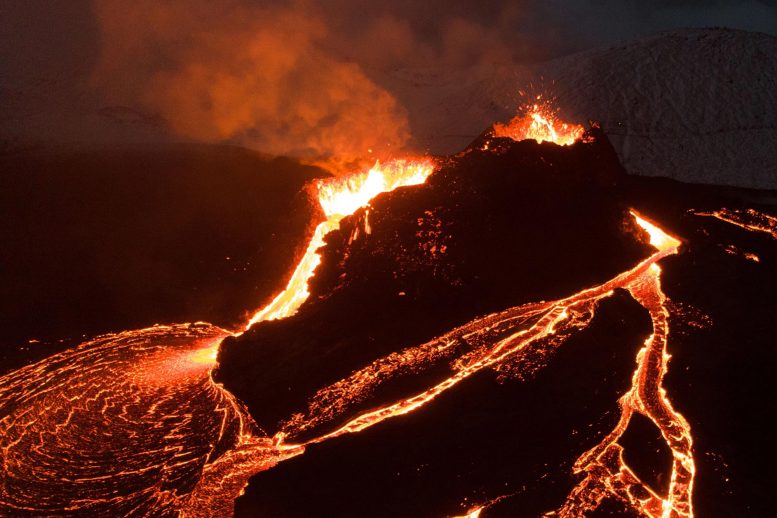
Research indicates volcanic hotspots vary significantly in temperature, challenging the notion they all arise from deep, hot mantle plumes. Some hotspots are cooler, suggesting other geological sources or processes may be involved, necessitating further investigation into their origins.
Hotspot temperatures vary more than previously thought, with some being much cooler, suggesting diverse origins and challenging traditional views on their formation.
The hotspots that created volcanic islands such as those of Hawaii, Iceland, and the Galapagos Islands may often prove surprisingly cool, a new study finds.
These findings suggest that such hotspots may not always originate from giant plumes of scorching hot rock welling up from near Earth’s core as previously thought, scientists noted.
Volcanoes are typically found near the borders of tectonic plates, born from clashes between those giant slabs of rock as they drift on top of the mantle layer between Earth’s core and crust. Classic examples of such volcanoes are those that make up the so-called Ring of Fire on the Pacific Rim.
However, volcanoes sometimes erupt in the middle of tectonic plates. The sources of these hotspots might be mantle plumes, mushroom-shaped pillars of hot rock ascending from the deep mantle to sear overlying material like a blowtorch. As tectonic plates wander over such plumes, geologists think chains of volcanic isles can emerge.
Previous research suggested volcanic hotspots are roughly 100 to 300 degrees Celsius (180-540 °F) hotter than mid-ocean ridges, where magma rises as tectonic plates spread apart underwater. This supported the view that hotspots were heated by matter from near Earth’s hot core and mid-ocean ridges by cooler mantle rock.
Now scientists find that many hotspots are dramatically cooler than previously thought, raising questions about their origins. “A substantial fraction of hotspots do not fit the classical plume model,” said Vedran Lekic, a seismologist at the University of Maryland, College Park, who did not participate in this study.
In the new study, researchers analyzed the velocity of seismic waves rippling through the mantle underneath oceanic hotspots and ridges to estimate temperatures at those sites. (Seismic waves travel faster through cold rock.)
Roughly 45% of hotspots are more than 155 °C (279 °F) hotter than mid-ocean ridges. However, about 40% are only 50 to 136 °C (90-245 °F) hotter than mid-ocean ridges, not particularly hot, and therefore not buoyant enough to support the active upwelling of rock from the deep mantle. What’s more, roughly 15% of hotspots are especially cold, only 36 °C hotter or less than mid-ocean ridges.
To shed light on the origins of these different varieties of hotspots, the scientists also examined the ratio of rarer helium-3 to more common helium-4 in their rock. (The atomic cores of helium-3 each possess just one neutron, whereas helium-4 nuclei each have two.)
Helium found in Earth’s crust is mostly helium-4 arising from the breakdown of uranium and other radioactive isotopes over time, whereas helium from deep within Earth is richer in helium-3, likely from reservoirs of ancient material preserving the original ratio found between these isotopes during Earth’s first days. The researchers discovered hot hotspots possessed a much higher ratio of helium-3 to helium-4 than cold hotspots did.
Although the classic model of hotspots originating from plumes welling up from the deep mantle may explain hot hotspots, including most of the famous ones, such as those underlying Hawaii, Iceland, the Galapagos, Samoa and Easter Island, “perhaps the truth is that only a few hotspots truly behave like our classical model of mantle plumes and hotspots,” said study co-author Carolina Lithgow-Bertelloni, a geodynamicist at the University of California, Los Angeles.
“This reinforces what some researchers have argued previously, which is that the term ‘hotspot’ is misleading and that volcanoes that don’t fit the plate tectonic paradigm should rather be referred to as ‘melting anomalies,'” said seismologist Ross Maguire from the University of New Mexico, who did not take part in this research.
Cooler hotspots may instead originate in the upper mantle, or from slow-moving deep plumes that have more time to cool, or from deep plumes that interact with and get cooled by swirling mantle rock. “If this is real, it will be a challenge for geodynamicists to explain such a finding,” said Bernhard Steinberger, a geodynamicist at the German Research Center for Geosciences in Potsdam, who was not a part of this work. “These results will doubtlessly trigger new research.”
All in all, “the classical view of plumes is not so much flawed than more complex than presented 30 to 50 years ago,” Lithgow-Bertelloni said.
Instead, this work “points to a much greater variety among plumes,” Steinberger said. “It is kind of like whenever you get a new close-up view of a planet or moon. It has some totally unexpected features. But it is still round.”
In the future, the scientists would like to analyze every hotspot in more detail to get an even better sense of their temperatures, Lithgow-Bertelloni said. They also aim to conduct more computer simulations testing various cool hotspot scenarios, she added.
The researchers detailed their findings in the January 7 issue of the journal Science.
Reference: “On the relative temperatures of Earth’s volcanic hotspots and mid-ocean ridges” by Xiyuan Bao, Carolina R. Lithgow-Bertelloni, Matthew G. Jackson and Barbara Romanowicz, Science.
DOI: 10.1126/science.abj8944









This is a very informative blog for me. I am very much benefited after reading this blog. Keep sharing.
https://www.mcdvoice.org/
i eat lava